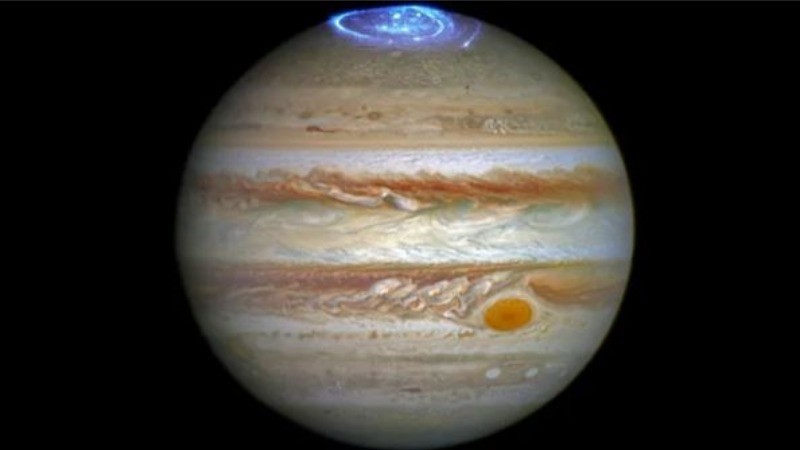
Washington: A spacecraft is set to launch on Monday from the Kennedy Space Center, embarking on a mission to hunt for signs of alien life on Europa, one of Jupiter's moons. Previous studies indicate that beneath Europa's frozen crust lies a vast salt-water ocean, potentially capable of supporting life forms. "We're going on a 1.8-billion-mile journey to an ocean world—Jupiter moon, Europa!" the U.S. space agency NASA announced this morning on X ahead of the anticipated blast-off.
NASA's flagship spacecraft, the Europa Clipper, represents the largest planetary mission developed by the agency. Originally scheduled to launch earlier, the mission was delayed due to Hurricane Milton, which swept through Florida on October 9-10. Both the Clipper and the SpaceX Falcon Heavy rocket are now secured inside a SpaceX hangar near their launch pad at NASA's Kennedy Space Center, according to agency officials.
The Europa Clipper mission has a budget of approximately $5.2 million. Following the launch, the spacecraft plans to fly by Mars in February 2025 and return by Earth in December 2026, utilizing the gravity of each planet to boost its momentum. These "gravity assists" will help the Europa Clipper achieve the velocity needed to reach Jupiter in April 2030.
Earlier, on April 14, 2023, the European Space Agency launched the Jupiter Icy Moons Explorer (Juice) mission from Europe’s Spaceport in French Guiana to study Jupiter and its three large ocean-bearing moons: Ganymede, Callisto, and Europa. However, Juice is expected to arrive at Jupiter only by July 2031.
The Europa Clipper spacecraft will travel 1.8 billion miles (2.9 billion kilometers) to reach Jupiter in April 2030, where it will orbit the planet and conduct 49 close flybys of Europa. During these flybys, the spacecraft's nine scientific instruments will collect data on the moon's atmosphere, icy crust, and the ocean beneath.
The nearly 10-foot-wide (3-meter) dish-shaped antenna, along with several smaller antennas, will transmit the collected data back to Earth, a journey that will take about 45 minutes when the spacecraft is in orbit around Jupiter. The antenna will operate on NASA's deep space X-band radio frequencies through the agency's Deep Space Network, a global array of large radio antennas that communicate with numerous spacecraft throughout the solar system.
Although the Europa Clipper is not a life-detection mission, NASA stated that understanding Europa's habitability will help scientists better understand how life developed on Earth and whether conditions that might support life exist beyond our planet. The spacecraft will be equipped with various instruments, including cameras, spectrometers, a magnetometer, and ice-penetrating radar, to study Europa's icy shell, the ocean beneath, and the composition of gases in the moon's atmosphere and surface geology.
Additionally, it will carry a thermal instrument to pinpoint warmer ice locations and any potential eruptions of water vapor. Strong evidence suggests that the ocean beneath Europa's crust contains twice the volume of all of Earth's oceans combined, according to NASA.
The mission involves scientists from NASA, the Jet Propulsion Lab, and the Johns Hopkins Applied Physics Lab. The history of exploration in this region dates back to 1610 when Galileo Galilei made the first detailed observations of Jupiter with a homemade telescope.
NASA's first spacecraft to visit the outer planets, Pioneer 10, was designed for a 21-month mission to Jupiter but lasted over 30 years, sending its last signal to Earth in January 2003 from a distance of 7.6 billion miles. Pioneer 11 followed closely in 1974, making its way to Saturn after flying by Jupiter. Voyager 1 and Voyager 2 also provided crucial data about Jupiter and its moons, including Europa.
The Galileo spacecraft orbited Jupiter for nearly eight years and dropped a probe into its atmosphere, while Cassini and New Horizons took detailed photographs of Jupiter on their respective journeys to Saturn and Pluto. NASA’s Juno spacecraft has been studying Jupiter from orbit since July 2016, probing beneath the planet's dense clouds to uncover insights about its origin and evolution, with investigations scheduled to continue through September 2025.
Union Minister Dharmendra Pradhan to Launch Three AI Centres of Excellence on October 15
India Rejects Canada's Allegations Against Diplomats, Citing Political Agenda
BJP Leader Rajeev Chandrasekhar Targets Congress Chief Kharge Over Land Allotment Controversy